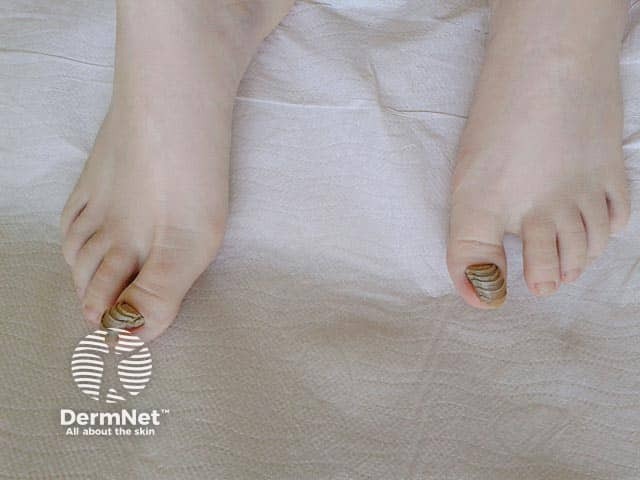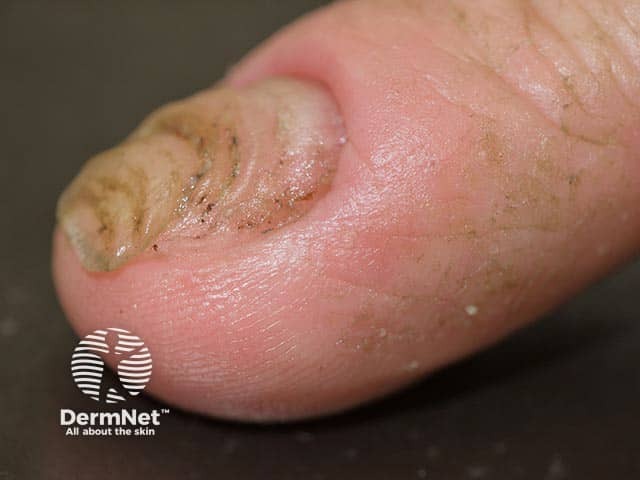Main menu
Common skin conditions

NEWS
Join DermNet PRO
Read more
Quick links
Shrimp nail — extra information
Shrimp nail
Last reviewed: May 2023
Author(s): Dr Libby Whittaker, DermNet Medical Writer, New Zealand (2023)
Reviewing dermatologist: Dr Ian Coulson
Edited by the DermNet content department
Introduction
Demographics
Causes
Clinical features
Complications
Diagnosis
Differential diagnoses
Treatment
Prevention
Outcome
What is shrimp nail?
Shrimp nail is a curved nail plate that appears similar to the back of a shrimp, caused by repeated onychomadesis. This type of nail disorder may be acquired or congenital.

Shrimp nail affecting the great toe - sequential onychomadesis resembling a crustacean (SN-patient2)

Bilateral shrimp great toenails (SN-patient2)

Lateral sequential ridges in early shrimp nail deformity (SN-patient1)
Who gets shrimp nail?
Onychomadesis can develop in both adults and children, including neonates.
There is limited information regarding the epidemiology of shrimp nail specifically. A 2015 Korean study of 21 patients with acquired great toenail dystrophy found that 17/21 had onychomadesis, and 3/17 (23.8%) of those with onychomadesis had shrimp nail.
What causes shrimp nail?
Nail disorders can be congenital or acquired.
Shrimp nail is caused by repeated onychomadesis, leading to pronounced vertical curvature of the nail. Onychomadesis is related to arrested growth of the nail matrix.
Causes of onychomadesis include:
- Trauma: single acute traumatic event to the nail, birth trauma in neonates, or repeated microtrauma (eg, due to poorly fitting shoes)
- Infection (eg, hand, foot, and mouth disease, chickenpox/varicella, COVID-19)
- Malnutrition/nutritional deficiency
- Autoimmune conditions (eg, cutaneous vasculitis, bullous pemphigoid, lichen planus, alopecia areata)
- Other dermatological or systemic conditions (eg, Stevens–Johnson syndrome / toxic epidermal necrolysis, Kawasaki disease)
- Drug-induced nail disease (eg, antiepileptics, chemotherapy)
- Rarely, congenital conditions such as congenital malalignment of the great toenails
- Idiopathic trigger.
What are the clinical features of shrimp nail?
- Vertical curvature of the nail with several ridges, resembling the curved back of a shrimp.
- Typically non-tender and asymptomatic.
- May affect a single nail or multiple nails (cause-dependent).
What are the complications of shrimp nail?
- Aesthetic concerns
- Secondary onychomycosis
- Secondary paronychia
- Onychocryptosis (ingrown toenail)
- Complete nail shedding
How is shrimp nail diagnosed?
Shrimp nail may be diagnosed clinically based on its characteristic appearance. A full history and examination should be done to assess for potential causes or triggers.
Nail clippings can be useful in differentiating from other diagnoses such as fungal nail infection.
What is the differential diagnosis for shrimp nail?
- Onychomycosis (fungal nail infection)
- Onycholysis (separation of nail plate from nail bed)
- Onychogryphosis (ram’s horn nail)
- Other nail disorders
What is the treatment for shrimp nail?
General measures
- Wear properly fitted shoes.
- Trim nails horizontally rather than rounding them at the edges, to reduce the risk of also developing an ingrown toenail.
- Minimise any other trauma to the affected nail/s.
Specific measures
- Treatment of underlying illness or withdrawal of any precipitating medication.
- In one case series, 32/44 patients with recurrent onychomadesis (not limited to shrimp nail specifically) benefited from topical application of urea cream.
- Topical halcinonide 0.1% has also been effective in a few cases of onychomadesis.
- Treatment of any secondary infection (eg, topical antifungals or oral antifungals for fungal nail infections; antibiotics for bacterial paronychia).
- Surgical options (eg, nail matricectomy) which will ablate the nail plate are not first-line, but may be considered if the nail dystrophy is interfering with daily life or if recurrent complications occur, such as nail infections or ingrown toenails.
How do you prevent shrimp nail?
Minimisation of nail trauma, good nail care and hygiene, and well-fitting footwear may help to reduce nail disorders such as shrimp nail.
What is the outcome for shrimp nail?
Onychomadesis and its specific forms, such as shrimp nail, are usually self-limited, although nail growth and healing can be a slow process. Spontaneous regrowth of a healthy nail will generally occur following resolution of any underlying condition or trigger such as infection or medication use.
Recurrence is possible, and minimisation of nail microtrauma through strategies such as wearing properly fitted shoes is important.
Bibliography
- Buttars B, Braswell MA, Huynh T, et al. Congenital malalignment of the great toenail and onychomadesis in monozygotic twins. JAAD Case Rep. 2021;14:1–3. doi: 10.1016/j.jdcr.2021.05.027. Journal
- Hardin J, Haber RM. Onychomadesis: literature review. Br J Dermatol. 2015;172(3):592–6. doi: 10.1111/bjd.13339. Journal
- Kim M, Kang JH, Cho BK, et al. Great toenail dystrophy: a single-center experience and review of the literature. Korean J Fam Med. 2015; 36(2):113–120. doi: 10.4082/kjfm.2015.36.2.113. Journal
- Salgado F, Handler MZ, Schwartz RA. Shedding light on onychomadesis. Cutis. 2017;99(1):33–36. Journal
- Sous D, Starace MVR, Chen L, et al. Recurrent onychomadesis of the toenails in children and adults: a case series. Skin Appendage Disord. 2022;8(1):31–33. doi: 10.1159/000519016. Journal
On DermNet
- Shrimp nail images
- Nail terminology
- Nail disorders
- Fungal nail infection (onychomycosis)
- Ingrown toenail (onychocryptosis)
Other websites
- Nail hygiene — Centres for Disease Control and Prevention (CDC)
- How to trim your nails — American Academy of Dermatology Association
